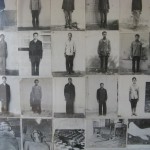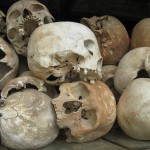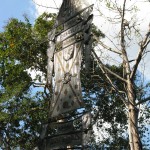For a little over three years till early 1979, Cambodia’s leaders savaged their own people. The numbers alone are chilling, with millions of Cambodians killed out of a population of perhaps 10 million, and at least tens of thousands tortured brutally.

We knew a little about this sad and savage bloodbath, but today we visited two sites that vividly recall its horrors and also honor its victims. Though a painful pilgrimage, a visit to these two sites is a necessary one for all visitors to Cambodia. For there where the victims suffered and died, you confront once again our endless capacity for harming each other and turning brutal when we can.
One site is Tuol Sleng near Phnom Penh’s center, a former school that leaders of the Khmer Rouge turned into one of their most infamous prisons and torture chambers. The people they victimized were considered capitalists (i.e., the educated, intellectuals including those who wore glasses, teachers, former government officials, and so on). Imitating Mao’s China in the sixties, they fostered class warfare, as the poor, the farmers, the have-nots, and the young took out their revenge on those who previously had.

Modern Cambodians can only wonder why or how could this happen among their own people. Pol Pot was not only a leader who seemed to seek freedom for all Cambodians, but was legitimized when the king Norodom Sihanouk joined with him. Lesser officials claimed, “We had no choice,” or “We were just obeying orders” in defense of their role in the atrocities here. Some of the responsible were tried and imprisoned years later, justice delayed due to ongoing geopolitical and internal battles in the area. Others went on to live their lives as if nothing had happened. Justice remains tentative and still somewhat remote, as Khmer Rouge soldiers to this day live peacefully in the countryside and many top people found natural deaths.

The other site is Choeung Ek, a killing field now within a placid suburban meadow a few miles from the city center. There the soldiers of the Khmer Rouge hauled around 10,000 Cambodians and Vietnamese in order to slaughter them and dump their bodies into mass graves. The final solution in their holocaust. And that is only one of nearly two hundred such sites around the country.
Yet it’s the stories we were told by our guides that haunt us, the stories that all Cambodians can tell of family members and loved ones.
One of our guides was a boy of seven, when he and other Cambodians cheered the victory of the Khmer Rouge in 1975, for they appeared to be liberating the country at last after years of turmoil and dependence. Within three days, however, the regime evacuated the city completely, as all were moved into the countryside to create a perverted socialist ideal of an agrarian society. His father, serving in a ministry for the existing government and therefore an enemy, was immediately arrested. He disappeared into Toul Sleng and was never seen again. What happened to his father he can only surmise from the horrific record of torture and slaying, for like the Nazis the jailers there kept precise information about their victims, and some survived to testify. But the records of the early prisoners were less meticulous so he cannot know for sure what happened.

With one family member accused, other relatives would soon be marked as suspect by local agents of the Khmer Rouge. Not even babies were spared. However, in his village, the boy’s mother had often charitably taken care of an outcast who later proved to be an agent for the Khmer Rouge. Instead of turning them in, the agent warned his mother of the danger, telling them to flee to the countryside where no one would know them.
So, after destroying any form of identification, they moved into the forested region adjacent to Vietnam, not to the lowland rice paddies that were easily screened by the Khmer Rouge soldiers. Wisely she carried with her various medicines and antibiotics that she shared with the tribal villagers there. That further caretaking saved them again. When soldiers came to find strangers, the grateful villagers warned her in advance so that she and the boy could hide deeper in the forest till the soldiers left. To this day, the villagers greet the boy and his mother as one of their own when they visit.
A different guide told us several stories stirred by a melodious song in fifties pop style on the radio. The singer was immensely popular in the early 70s, adored like Elvis or Michael Jackson at their peak, and considered the “golden voice.” She, along with other artists, were killed by Khmer Rouge officials during that time, for their form of collaboration with the old life or out of revenge perhaps.
And he told of his aunt who watched soldiers drag her husband out of their home and kill him in front of her. And how his father escaped that fate. The local leaders of their village told him that he was lucky and one of 20 scheduled for a training program. His father only needed to show up at a given time with the others. But, intentionally it seems, he missed the transport vehicle and found a way to evade capture later. The others, he later found out, were taken to a killing field, hands bound behind them and tethered to each other. There, each had to kill the man in front of him with a sharp blow before it was his own grim turn. Reeducation, the people sadly learned, was the regime’s code word for forced labor camps at best and fatal brutality at worst.
Another survivor told of escaping by falling over with the man in front of him as a set of soldiers fired shots along the line. Covered by the blood and debris like the dead and still despite the kicks of the soldiers to confirm the deaths, he waited till night and fled alive from the killing fields.
Surprisingly philosophical after telling us these sorrowful stories, after the “golden voice” stopped singing, our guide commented that in the Angkor period Cambodia was strong, then weakened, so other nations around it could subdue them. In the 20th century, Cambodians fought and killed each other so they had to begin again from almost nothing. From what we’ve seen they have risen, but have a long way to go.
That is their heritage of the red and the white, the color of blood and the color with which Cambodians honor the dead. The tinctures of their sorrow.

For more pictures from Cambodia, CLICK HERE to see the slideshow at the end of the Cambodia itinerary page.)

